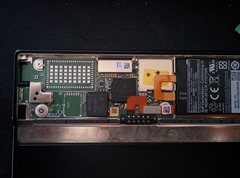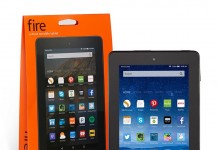 A Mobileread user has popped the back off his Kindle Oasis and revealed what’s inside. Better him than me—I’m certainly not curious or brave enough to risk damaging a $290 device, even if I could afford one. As for what it reveals, that’s more of an open question. The Mobileread thread following the photo posts devolves into discussion of the fact that the Oasis apparently lacks serial port pins, which raises questions about how to debrick the Kindle should something go wrong with it.
A Mobileread user has popped the back off his Kindle Oasis and revealed what’s inside. Better him than me—I’m certainly not curious or brave enough to risk damaging a $290 device, even if I could afford one. As for what it reveals, that’s more of an open question. The Mobileread thread following the photo posts devolves into discussion of the fact that the Oasis apparently lacks serial port pins, which raises questions about how to debrick the Kindle should something go wrong with it.
The internal battery is a 245 milli-amp hour battery, which is hardly any juice at all—for comparison, the Kindle Paperwhite’s battery is 1420 mAh, my Nexus 6 smartphone’s battery has 3220 mAh, and the Anker battery about the size of a tube of lipstick I carry in my pocket is 3350 mAh. The fact that you can get days of reading time out of 1420 mAh or hours out of 245 mAh is a testament to how little juice e-ink actually takes—and most of the battery consumption from those is probably due to the LED lights. (There’s no word on how much juice resides in the Oasis’s battery cover, but I’ll guess it’s another 1420 mAh battery like the Paperwhite’s, or something on the same order.)
Peering at a couple of the chips on the circuit board, one of them has the 8-diamond Freescale logo—obviously some kind of CPU, though I’m not able to make out the letters and numbers clearly enough to find any information on which one. Another chip says SEC on it—Samsung Electronics Corporation flash memory. I don’t know enough about the parts to be able to say with any certainty what they are beyond that.
At The Digital Reader, Nate Hoffelder notes the lack of a visible wireless chip on the board. However, this doesn’t seem to mean much to me—the Oasis obviously has Wi-Fi, so it has to come from somewhere. At least one Freescale system-on-chip configuration (PDF) supports both Wi-Fi and Bluetooth (though I don’t know if that’s the same one this Kindle has), so that seems like the most obvious place to look for it here.
If that’s the case, it might well have Bluetooth capability, too—though whether it ever uses it would be up to the firmware, and to whatever Amazon’s intentions are for the device. Plenty of computer chips ship with unused capabilities and components in them, simply because it costs less to use parts of one chip than to commission an entirely new chip design. That’s why so many cheap Celerons were so insanely overclockable—they were actually more-expensive chips sold underclocked.
Perhaps we’ll learn more when one of the big teardown sites performs its own e-reader vivisection and specifically identifies the parts. In any event, one of the more interesting observations came from Will O’Neil, who commented on Nate’s post that the Oasis seems designed to be easily repaired. It doesn’t surprise me that should be the case; it will be a lot more economical to repair a $290 e-reader than one that only costs $80.

































Based on the design of the Echo, there will be a discrete wireless chip, and it will be on the backside of the board.
That’s another possibility I almost thought to mention, but I had thought they’d put all the chips on one side. Either way, it remains to be seen what it will look like.
Like you, I’m surprised by the tiny labeled capacity of that battery. The reading part may not consume that much power, but WiFi certainly can. Amazon made a big deal about turning off WiFi in my Kindle 3 to add to the battery life.
The Oasis may be far more dependent on the battery in that cover that Amazon has let on thus far. You won’t be able to leave it home when you go on vacation. Users may not be happy about that.